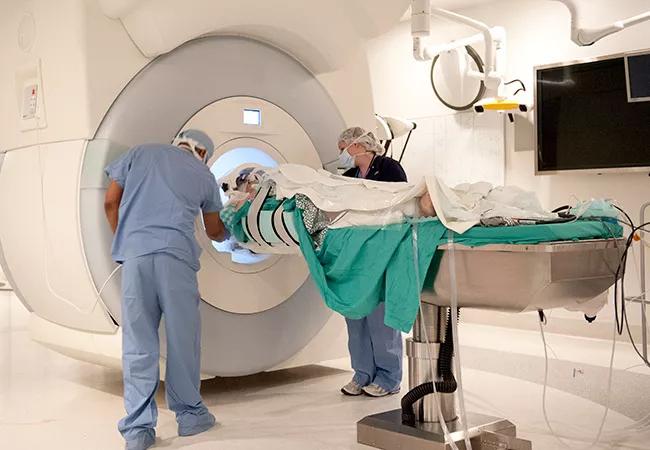Experienced team, patient selection are critical

Advertisement
Cleveland Clinic is a non-profit academic medical center. Advertising on our site helps support our mission. We do not endorse non-Cleveland Clinic products or services. Policy
Deep brain stimulation (DBS) is FDA-approved for the treatment of Parkinson’s disease and essential tremor. Its use in the United States and abroad is now routine for these conditions, but the role of DBS for other movement disorders is less well established. Patients with dystonia in particular have responded favorably to this therapy. However, because this is a rare disease, large randomized trials are unlikely. Fortunately, in 2003 DBS was approved by the FDA for the treatment of chronic, intractable dystonia under a Humanitarian Device Exemption. Evidence to date indicates that success rates are higher for patients with primary dystonia than for those with secondary forms.
This post reviews the case of a patient with primary dystonia who was evaluated and eventually implanted with a DBS system. We conclude with some general insights that can be applied to this promising but still-uncommon application of neuromodulation therapy.
A patient was referred to Cleveland Clinic’s Center for Neurological Restoration by her local physician. Abnormal movements were first noted during her childhood after her parents reported the onset of an abnormal gait. Within the year, her muscle control worsened, with involvement of her extremities and neck, and generalized dystonia was diagnosed.
Over the years, the patient tried various medications, with little success. She started botulinum toxin injections to the legs, hip, lower and upper back, and tongue, but these provided only temporary relief. She presented to Cleveland Clinic seeking improved control of her symptoms, which caused pain, fatigue and distress. Her movement abnormalities were readily apparent on physical examination, during which she exhibited the typical involuntary spasms of dystonia. Oral/mandibular and voice symptoms were minimal.
Advertisement
Laboratory testing and MRI at presentation were unremarkable. A secondary cause of dystonia was not identified. Genetic testing was positive for an uncommon variant of primary dystonia that manifests at a young age and progresses relentlessly with severe symptoms.
The patient was also assessed via movement testing, neuropsychological tests and psychiatric evaluation. Review of results led her multidisciplinary clinical team to consensus that she would be a good candidate for DBS, which the patient agreed to after discussion.
The first stage of the two-stage DBS implantation procedure involves targeted electrode placement using a frame-based navigation system (Leksell Stereotactic System®) in Cleveland Clinic’s intraoperative MRI suite. Use of intraoperative MRI enables lead localization during surgery.
Two leads were implanted through the frontal region of the skull — one in the right globus pallidus and the other in the left globus pallidus. This site is routinely used to treat dystonia. The MRI scanner, suspended from the ceiling on rails, was advanced into the operating room to confirm the position of insertion. The leads were secured and the wires left under the skin before closure of the incision. The patient was discharged a few days later with no complications.
A few weeks later, she underwent a second surgery to connect the leads to a battery pack placed under the skin in the chest wall.
One month later, the patient came in for programming of the battery. This typically takes several hours, as various stimulation parameters are adjusted. The goal is to achieve naturalization of muscle movements while avoiding excessive stimulation, which may cause numbness, tingling, electrical sensations, muscle pulling and slurred speech. Several programming sessions are typically needed to optimize settings, especially in patients with dystonia. Two months after implantation, the patient had recovered well from the surgery and continued to follow up for optimization of settings.
Advertisement
This case of an unusual but important cause of dystonia illustrates several key points, outlined below.
Appropriate patient selection is critical. DBS can be considered in patients with generalized and segmental dystonia, hemidystonia and cervical dystonia (torticollis) who do not respond adequately to oral medications and botulinum toxin injections. Ideally, it should be embarked upon in adolescence or young adulthood, before musculoskeletal deformity and complications become intractable. Patients should undergo thorough neuropsychological and medical evaluation, including genetic testing, before considering DBS.
An experienced team helps ensure successful outcome. DBS for uncommon or complex conditions should be undertaken only at a center with advanced technology, expertise and experience in treating such conditions. A team approach comprising neurologists, neurosurgeons, psychiatrists, programmers and technicians is key to good outcomes and minimizing complication rates.
Results can take time. Unlike in the setting of Parkinson’s disease or tremors, the effects of DBS for dystonia are not often seen immediately upon stimulation, and benefits may take several weeks to a few months to become evident.
Dr. Nagel is a neurosurgeon in Cleveland Clinic’s Center for Neurological Restoration specializing in functional and restorative neurosurgery.
Advertisement
Advertisement

Large NIH-funded investigation is exploring this understudied phenomenon

Advances in genomics, spinal fluid analysis, wearable-based patient monitoring and more

Case study of radial-to-axillary nerve transfer for tumor-related deltoid nerve injury

An update on the technology from the busiest Gamma Knife center in the Americas

Real-time adjustments may help reduce bothersome dyskinesias

Anatomical modeling can identify optimal surgical candidates, study suggests

Add AI to the list of tools expected to advance care for pain patients

New guidelines from Brain Trauma Foundation urge early and aggressive treatment